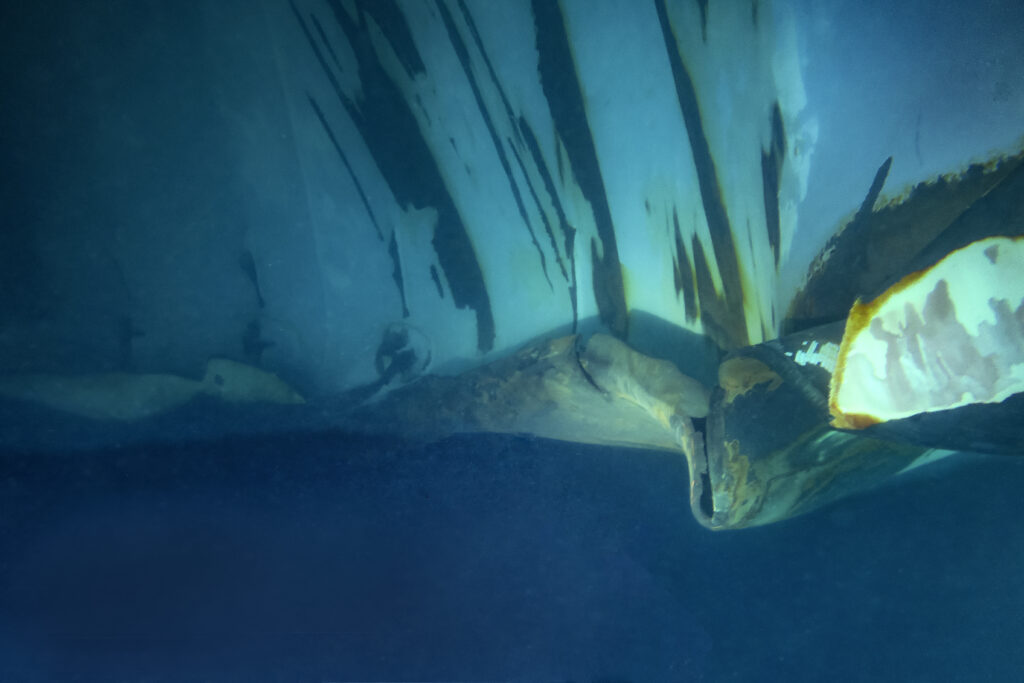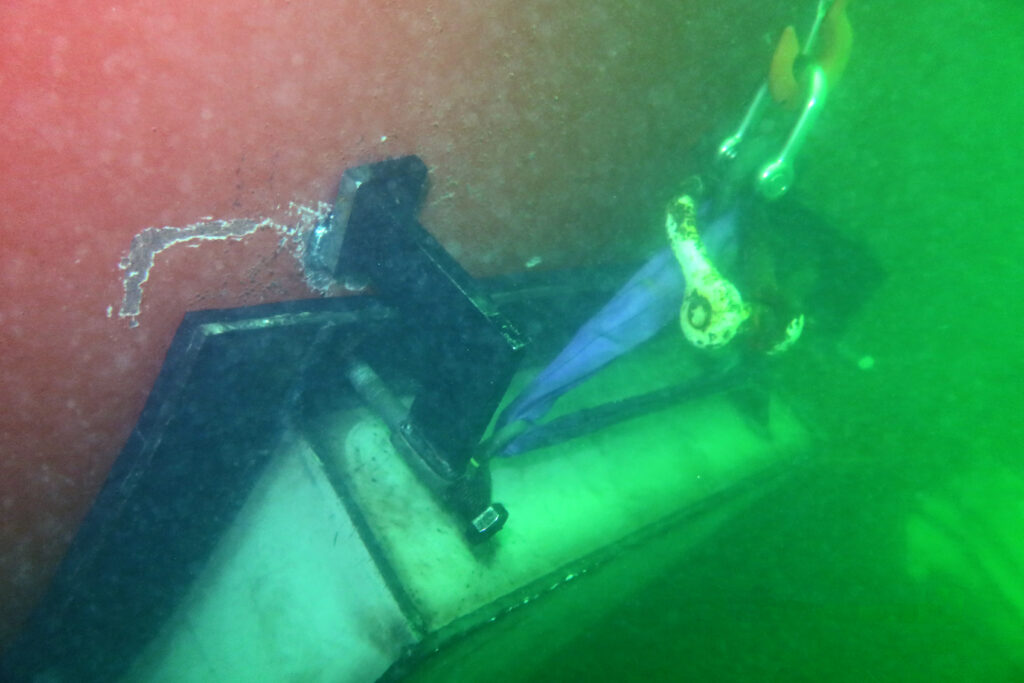In 2023 our divers flew across the globe to perform the full range of our underwater repairs. They worked on tankers, bulkers, cruise ships, roro vessels and container and drill ships to name a few.
Recently our teams traveled across different continents and carried out seal repairs on five vessels in just over a month. They also performed routine insert repairs as well as tailor-made complex shell plating operations as far as Oman and Papua New Guinea. And there are many more examples.
In this article we look back at a small selection to illustrate the diversity of the services we offer our customers.
45-ton cofferdam repair after a severe grounding
When a fully laden bulk carrier suffered heavy damages from a grounding in Suez, the owners and management’s first thought was to call Hydrex. In this case the ship was carrying a valuable cargo and every day she was out of action represented a huge loss to the owners.

Based on the initial inspection and rough measurements, a plan was proposed to carry out precise measurements of the hull where the large damage occurred so that a cofferdam could be designed which would then be installed to make the hull watertight so that the water ballast tanks could be pumped out.
As soon as the fabrication was completed by a local workshop, we flew back to Suez. After some needed modification, the massive, 45-ton cofferdam was lowered into position by crane and secured against the hull.

The pressure of the water was, however, too much for the structurally weak hull which started to cave in under the force. It became clear that the ship had suffered too much internal damage to permit the water ballast tanks to be fully pumped out. This was not something that could have been predicted or remedied with the ship afloat.
In order to reinforce the bulkhead between the water ballast tanks, a new plan was proposed to build cement boxes and pour concrete to provide enough strength for the bulkheads in between the ballast tanks. But WBT 2 port could not be emptied. Part of the plan, therefore, was to lighter the ship as necessary until the class-required draft could be achieved.
With the cement boxes in place, the cofferdam was fully secured, and successful sea trials were conducted. The cofferdam remained firmly in place until it could be removed when the ship was in drydock and permanent hull repairs could be carried out.

Bow thruster removal and reinstallation in Naples
To save time and money for the owner of a 200-meter roro ship, our divers removed the bow thruster of the ship and reinstalled the unit after it was overhauled while the vessel was at anchorage in Naples, Italy. By carrying out both parts of the operation underwater the ship could stay operational and did not have to go to drydock.
After the team set up a monitoring station next to the vessel, the divers started the operation with a detailed inspection of the bow thruster and tunnel. In the meantime, initial preparations were made in the bow thruster engine room for the removal of the unit so that there would be no ingress of water once it was taken out.

The divers first action was to take off the external thruster tunnel grids to provide access for removal of the unit. Next pad eyes were welded inside the tunnel to hoist the thruster unit up and down.
The next step was to secure the gearbox with hoisting equipment. The team then disconnected the unit from the engine room and removed it from the thruster tunnel. It was then brought to the surface where it was overhauled by the OEM’s technician, with assistance of our diver/technicians.

Because the thruster was fully assembled and prepared, it could be installed in its entirety without the need to create a dry environment in the tunnel as is required when the blades are installed separately. Our diver/technicians lowered it into the water and brought it into the thruster tunnel. The team secured the unit and connected it to the engine room.
The operation ended with the removal of the pad eyes and the reinstallation of the thruster tunnel grids.
Underwater insert repair on bulker
We were contacted by the owner of a 200-meter bulker which had grounded. The ship had suffered a crack in the bottom plating of one of its ballast water tanks. We were asked if we could provide an underwater solution that would keep the vessel out of drydock. A team of our diver/technicians therefore mobilized to Fos-sur-Mer, France, to perform on-site repairs.
After arriving on site, the team first performed an on-board and underwater inspection of the damaged area. This revealed a large L-shaped crack in the ballast water tank of cargo hold 2. In close communication with the superintendent of the vessel and the attending class surveyor, it was decided that a 1000 x 820 mm insert would need to be installed.

The new insert plate, and a mobdock measuring 1500 x 1300 mm were fabricated at the Hydrex headquarters in Antwerp.
The divers started the operation by installing the cofferdam on the waterside of the affected plating. To be able to access the crack in the ballast water tank from the inside, the team made an opening in the bilge hopper covering the crack. A frame and support brackets were also removed.
This allowed our diver/technicians to cut away the crack and the surrounding area. The new plate was then inserted into the hull and secured using full penetration welding following our class-approved procedure.

The next step was the reinstallation of the frame and support brackets. A new insert was then positioned in the bilge hopper. This plate was welded following the same class-approved procedure.
An independent NDT inspector approved the insert repair, and the classification surveyor who was present during the operation gave it a green light.

Underwater stern tube seal repair on container ship
One of our diver/technician teams carried out an underwater stern tube seal repair on a ro-ro ship berthed in Algeciras. The ship was leaking oil, making on-site repairs necessary.
Working together with the OEM allowed us to provide our customer with original spare parts which guarantees the best quality material. A technician from the seal manufacturer was present during the repair.

Taking advantage of the Hydrex flexible mobdock technique, the entire operation could be completed with the ship afloat and carrying out normal activities. Because all the required equipment is ready to be transported at all times, no time was lost making preparations.
Scrubber overboard pipe operations in Denmark
We performed scrubber overboard pipe repairs on two 298-meter LNG carriers in Munkebo, Denmark. In total seven corroded pipes were repaired. On five pipes the corroded areas of the scrubber pipes were ground out and rewelded. The pipes were then protected with Ecospeed, a chemically resistant coating produced by Subsea Industries. The same protection was given to the two new pipes that were installed.

Because of the location of the damaged parts of the pipes, welding work on the inside shell plating of the hull was needed. As a result, the outside of the overboards could not be sealed off with a simple patch. Custom cofferdams were designed and constructed at our workshop.

After the installation of the cofferdams, the team cut away the old pipes. The shell plating was then prepared for the installation of the replacement part. New pipes had also been constructed at our workshop in Antwerp. The pipes were then positioned and secured with a full penetration weld. Next an independent inspector carried out NDT testing of the welding work.
Our diver/welders then sealed off the outlet of the final overboard pipe. The team ground away the corroded area before rebuilding it back to its original thickness.
When the welding was complete the surface was cleaned and a Magnetic Particle Inspection (MPI) was carried out by an independent inspector.

Underwater bilge keel repair in Singapore
One of our teams mobilized to Singapore for a crack repair on a 360-meter bulker. After arriving on site, the team first performed an on-board and underwater inspection of the damaged area. This revealed a crack measuring 232 mm just behind the start of the landing plate of the bilge keel section.
There was a high current where the vessel was anchored. As a result there was little diving time available to work in. The divers could only work during slack tide before the current became too much to allow diving operations.
In close communication with the customer, it was decided to save time by grinding out the crack and rewelding it instead of installing a new insert.
The bilge keel and landing plate were then partially cropped to allow for the installation of a cofferdam on the outside of the hull over the damage. The team could then work on the crack inside the ballast tank without water ingress. The crack was ground out over its entire length and filled with our class approved full penetration welding.
Next the cofferdam was removed and the bilge keel was further adapted to the correct shape. The cropped landing plate was fully welded and closed again.

Propeller blade repair in Lithuania
A successful propeller blade cropping was done on a 175-meter bulker while the vessel was in Klaipeda, Lithuania. Because of the severity of the damage, cropping was the only option.
When the propeller blades of the bulker were damaged as a result of impact with ice, a fast on-site solution was needed to restore the propeller’s balance with a minimal loss of efficiency. This would avoid an extended off-hire period to go to drydock.

One of our teams was therefore rapidly mobilized to the ship’s location in Lithuania. After they arrived at the vessel’s location they started the operation with a detailed survey of the affected propeller blades. Because the ship could be trimmed by the bow, the entire operation could be performed above water.
The team used the information acquired during the inspection to calculate and determine the ideal cutting lines. They then cropped the damaged blades and ground the edges to give them the correct shape.
When the cropping was complete, the blades were polished to make sure that any remaining loss of efficiency would be minimal.

Conclusion
When we send a team to an operation, any operation, we have one goal in mind: to get the job done in the shortest possible time and to the highest standards. This has been our policy since Hydrex was founded 50 years ago.
We understand how important it is for a ship to keep its schedule. Going off-hire for days or even weeks to have underwater repairs carried out or pay an unscheduled visit to a drydock costs a tremendous amount of money. Usually we can carry out the job with the ship still afloat, much more quickly and at far lower cost.
Feel free to contact us with any question you might have. Our technical advisors will give you fast and clear answers and will let you know whether an underwater solution is possible.
If ever you need assistance with the underwater part of your vessel, give us a call. We can then tell you if the repair is feasible and start working on its handling.
+32 3 213 53 00
hydrex@hydrex.be
Click on the images below for more case studies.

Underwater repair of leaking seal assembly in Trinidad

Underwater bow thruster removal and reinstallation in Australia

Scrubber overboard pipe repairs in Belgium and the Netherlands

Insert installation in Uruguay prevents loss of contract

Double stern tube seal repair on second vessel in Tasmania confirms customer’s trust



